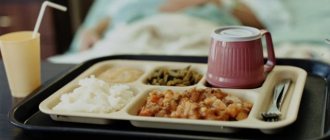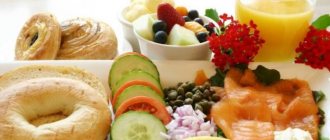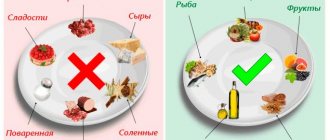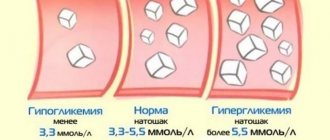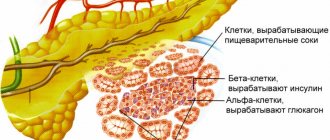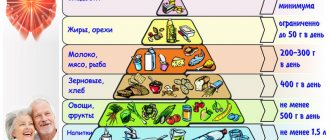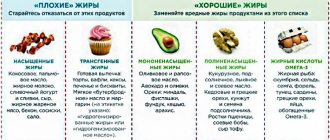General rules
What is diabetes mellitus and what diet is indicated for this disease? Diabetes mellitus is a disease that occurs when the pancreas does not produce enough insulin. It often develops with a hereditary predisposition, and one of the factors contributing to its development is overeating, excess consumption of fats and simple carbohydrates. The disease is based on carbohydrate metabolism disorders: poor absorption of glucose by tissues, increased formation of it from fats, proteins and glycogen .
As a result, there is an increase in blood sugar and its determination in the urine. Diabetics are also characterized by disorders of fat metabolism and accumulation of fat oxidation products in the blood - ketone bodies .
Diabetes mellitus is complicated by atherosclerosis , fatty liver , and kidney damage. Nutrition is a therapeutic factor in mild forms of the disease, the main point in moderate diabetes, and necessary for the treatment of severe forms while taking insulin and oral hypoglycemic drugs.
Patients are prescribed Diet No. 9, Table No. 9 according to Pevzner or its variations. This medical diet provides for the normalization of carbohydrate metabolism, and a balanced diet prevents disorders of fat metabolism. Dietary Table No. 9 is distinguished by a moderately reduced energy value due to a significant reduction in carbohydrates (easily digestible, simple) and fats. Sugar and confectionery products are excluded, salt and cholesterol . The amount of proteins is within the physiological norm. Therapeutic nutrition is prescribed by a doctor depending on the degree of hyperglycemia , the patient’s weight and concomitant diseases.
With normal weight, the daily calorie intake is 2300-2500 kcal, 90-100 g of protein, 75-80 g of fat and 300-350 g of carbohydrates, which, at the discretion of the doctor, is distributed between intake with bread or cereals and vegetables.
Nutrition is of particular importance when combined with obesity . Weight loss has a beneficial effect on the course of diabetes - reduced sensitivity to insulin . If you are overweight, calorie content is reduced to 1700 kcal due to a significant restriction of carbohydrates to 120 g per day. In this case, the patient receives 110 g of protein and 80 g of fat. The patient is also shown fasting diets and days.
Diet table No. 9 for mild diabetes mellitus
- sugar;
- preserves, jams;
- confectionery;
- ice cream;
- syrups;
- sweet fruits and vegetables;
- pasta;
- White bread.
It is recommended to limit or exclude:
- potatoes, as a highly starchy product;
- carrots (for the same reasons);
- tomatoes due to their high glucose content;
- beets (has a high glycemic index, after its consumption there is a jump in blood sugar levels).
Since nutrition for diabetes is based on limiting carbohydrates, it is advisable to choose even fruits with a glycemic index (GI) of up to 55: grapefruits, lingonberries, apricots, cherry plums, apples, cranberries, peaches, plums, cherries, sea buckthorn, red currants, gooseberries. But even these fruits should be consumed in limited quantities (serving up to 200 g).
When consuming foods with a high GI, blood sugar levels rise greatly, which causes increased insulin . It should also be taken into account that heat treatment of vegetables increases the GI, so stewed zucchini, eggplant, and cabbage can adversely affect sugar levels.
It must be remembered that sugar and its products are excluded in mild cases of the disease, and against the background of insulin therapy for moderate and severe diabetes mellitus, 20-30 g of sugar are allowed. Thus, the treatment table is modified by the doctor depending on the severity of the disease, the intensity of the patient’s work, weight, age and insulin therapy. This is done by regulating carbohydrate content.
In all cases, be sure to include in the diet:
- eggplant;
- red salad pepper due to its high vitamin ;
- pumpkin (helps reduce glucose);
- zucchini and squash, which normalize carbohydrate metabolism;
- lipotropic products (cottage cheese, oatmeal, soy).
Since carbohydrates must be present in the diet and provide 55% of the daily energy value, it is necessary to include sources of slowly absorbed carbohydrates with dietary fiber: wholemeal bread, legumes, whole grain cereals, vegetables, fruits.
It is advisable to adhere to the following distribution of the energy value of the diet:
- 20% should be for breakfast;
- 10% - for second breakfast;
- 30% - for lunch;
- 10% - afternoon snack;
- 20% - dinner;
- 10% on overnight meals.
The diet includes xylitol , fructose , or sorbitol at the expense of total carbohydrates. For taste, it is allowed to add saccharin .
Xylitol is equivalent in sweetness to regular sugar and its daily dose is no more than 30 g.
Fructose has low calorie content and low GI, and is twice as sweet as sugar, so adding 1 tsp is enough. in tea. With this dietary diet, the amount of salt is limited (12 g per day), and according to indications (for nephropathy and hypertension ) it is further reduced (2.8 g per day).
Basics of nutrition for type 2 diabetes mellitus
The main component in the treatment of diabetes is the patient’s self-discipline. Constant monitoring of blood glucose levels and a balanced diet help maintain quality of life for a long time.
It is based on:
- The presence of a large amount of fiber (50%) in the daily diet prevents the development of the disease and stabilizes the condition of diabetes. This rule must be observed in each portion, regardless of its volume.
- All components of proteins, fats and carbohydrates must be included in food. If a patient, when choosing a diet, excludes at least one of the 3 main components of nutrition, he causes irreparable harm to his body.
- Protein is necessary for muscle mass, immune support, hormonal levels, skin and hair condition. All hormones in the human body have a protein structure.
- Chicken and fish should be chosen with the least amount of fat, while maintaining the required amount of protein.
- In this form of diabetes, fat is contraindicated. Vegetables and meat are prepared in any way (baked, boiled, steamed, used in salads) except frying. The body has enough fat, which it will secrete from the food it eats.
- Vegetables slow down the absorption of carbohydrates found in other foods.
Varieties
Basic Table No. 9 is prescribed for a short period of time to determine tolerance to carbohydrates and to select doses of oral medications in cases where diet fails to normalize sugar levels. During the trial diet, fasting sugar is checked once every 3-5 days. When test results are normalized, after 2-3 weeks the diet is gradually expanded, adding 1 XE (bread unit) every week.
One unit of bread corresponds to 12-15 g of carbohydrates and is contained in 25-30 g of bread, 0.5 cup of buckwheat porridge, 1 apple, 2 pcs. prunes Having expanded it by 12 XE, it is prescribed for 2 months, after which another 4 XE are added. Further expansion of the diet is carried out after 1 year. The table is also indicated for ongoing use in mild to moderate type 2 diabetes
Diet 9A is recommended for mild to moderate forms of non-insulin-dependent diabetes, but patients obesity
Table No. 9B is indicated for patients with severe insulin-dependent diabetes, and it differs from the previous ones in its increased carbohydrate content (400-450 g) due to the consumption of bread, potatoes, cereals, vegetables and fruits. The amount of proteins and fats has been slightly increased. We can say that the diet is close in composition to a rational table. Its energy value is 2700-3100 kcal. Instead of sugar, use sweeteners and 20-30 g of sugar.
If the patient administers insulin in the morning and afternoon, then 65-70% of carbohydrates should come from these meals. After administering insulin, food should be taken twice - after 15-20 minutes and after 2.5-3 hours, when the maximum effect of insulin is noted. This is ensured by fractional meals with the intake of carbohydrate foods (porridge, potatoes, fruits, fruit juices, bread) for the 2nd breakfast and afternoon snack.
Differences in diet No. 9
A universal non-strict diet (table 9) is used as a preventive measure for existing type 2 diabetes mellitus by normalizing metabolic processes in the body and determining the calculated individual dose of insulin.
Features of proper eating behavior for the treatment of type 1 and type 2 diabetes:
- compulsory hearty breakfast;
- fractional 5-6 meals a day, strictly at the allotted hours;
- overeating is unacceptable;
- complete exclusion from the menu of fast food and other sources of trans fats;
- replacing a dish made from easily digestible refined carbohydrates with a product containing carbohydrates that slowly convert into glucose;
- balanced and evenly distributed carbohydrate intake throughout the day;
- the main role in the menu is given to vegetables, especially raw ones, and protein products;
- minimal consumption of fatty, cholesterol-rich foods;
- reducing the amount of salt taken;
- limited use of sweeteners (saccharin, xylitol, sorbitol) or the natural sweetener stevia;
- frying is a prohibited culinary processing of a dish.
The diet includes chemical components:
- animal proteins and vegetable fats 80 grams per day;
- about 300 grams of complex carbohydrates;
- 12 g salt;
- 1.5-2 liters of water.
To control the amount of carbohydrates, bread units are counted. 12 grams of carbohydrates are equal to 1 XE (25 grams of bread). The content of bread units in 1 meal should not exceed 6.
Authorized Products
The consumption of rye bread, wheat bread (from second grade flour), with bran up to 300 g per day is provided.
First courses can be made with weak meat or vegetable broth. Preference should be given to vegetable soups (borscht, cabbage soup), okroshka, mushroom soup; soups with meatballs and cereals are also allowed. Potatoes in soups may be present in limited quantities.
Proper nutrition for diabetes
Dietary food includes all vegetables that are used raw or stewed (as side dishes). The emphasis is on low-carbohydrate vegetables (pumpkin, zucchini, eggplant, cucumbers, lettuce, cabbage, squash). Potatoes are allowed with restrictions taking into account the carbohydrate norm for each patient individually (most often no more than 200 g in all dishes). Carrots and beets are high in carbohydrates. With the doctor's permission, these vegetables are also included in the diet.
Lean meats and chicken are allowed. It is better to cook meat dishes boiled or baked to reduce the calorie content of food. When it comes to fish, you should choose dietary types: pike perch, cod, hake, pollock, pike, navaga. The amount of cereal is limited to the norm for each patient (usually 8-10 tablespoons per day) - buckwheat, barley, pearl barley, millet and oatmeal; legumes are allowed (lentils are preferable). If you have eaten pasta (in limited quantities and occasionally), then on this day you need to reduce the amount of bread.
Fermented milk drinks (low-fat kefir, yogurt) should be included in the diet daily. Milk and low-fat cottage cheese are consumed in their natural form and dishes are prepared from them: milk porridges, casseroles, soufflés. Mild cheese with a fat content of no more than 30% is allowed in small quantities; sour cream is added only to dishes. Butter and various vegetable oils should be added to prepared dishes. Eggs - one per day, soft-boiled or in the form of an omelet. Drinks allowed: coffee with milk, tea with sweetener, vegetable juices, rosehip decoction.
Sweet and sour berries are allowed in any form (fresh, compotes, jellies, mousses, xylitol jam). If you use xylitol , then no more than 30 g per day, fructose is allowed 1 tsp. three times a day (add to drinks). Honey 1 tsp. 2 times a day. You can eat confectionery products (sweets, waffles, cookies) with sugar substitutes. But even in this case, there is a norm - 1-2 candies twice a week.
Table of permitted products
| Proteins, g | Fats, g | Carbohydrates, g | Calories, kcal | |
Vegetables and greens | ||||
| zucchini | 0,6 | 0,3 | 4,6 | 24 |
| cabbage | 1,8 | 0,1 | 4,7 | 27 |
| sauerkraut | 1,8 | 0,1 | 4,4 | 19 |
| cauliflower | 2,5 | 0,3 | 5,4 | 30 |
| cucumbers | 0,8 | 0,1 | 2,8 | 15 |
| radish | 1,2 | 0,1 | 3,4 | 19 |
| tomatoes | 0,6 | 0,2 | 4,2 | 20 |
| pumpkin | 1,3 | 0,3 | 7,7 | 28 |
Fruits | ||||
| apricots | 0,9 | 0,1 | 10,8 | 41 |
| watermelon | 0,6 | 0,1 | 5,8 | 25 |
| cherry | 0,8 | 0,5 | 11,3 | 52 |
| pears | 0,4 | 0,3 | 10,9 | 42 |
| nectarine | 0,9 | 0,2 | 11,8 | 48 |
| peaches | 0,9 | 0,1 | 11,3 | 46 |
| plums | 0,8 | 0,3 | 9,6 | 42 |
| apples | 0,4 | 0,4 | 9,8 | 47 |
Berries | ||||
| cowberry | 0,7 | 0,5 | 9,6 | 43 |
| blackberry | 2,0 | 0,0 | 6,4 | 31 |
| raspberries | 0,8 | 0,5 | 8,3 | 46 |
| currant | 1,0 | 0,4 | 7,5 | 43 |
Cereals and porridges | ||||
| buckwheat (kernel) | 12,6 | 3,3 | 62,1 | 313 |
| oat groats | 12,3 | 6,1 | 59,5 | 342 |
| corn grits | 8,3 | 1,2 | 75,0 | 337 |
| pearl barley | 9,3 | 1,1 | 73,7 | 320 |
| millet cereal | 11,5 | 3,3 | 69,3 | 348 |
| barley grits | 10,4 | 1,3 | 66,3 | 324 |
Bakery products | ||||
| Rye bread | 6,6 | 1,2 | 34,2 | 165 |
| bran bread | 7,5 | 1,3 | 45,2 | 227 |
| doctor's bread | 8,2 | 2,6 | 46,3 | 242 |
| whole grain bread | 10,1 | 2,3 | 57,1 | 295 |
Confectionery | ||||
| diabetic crackers | 10,5 | 5,7 | 73,1 | 388 |
Raw materials and seasonings | ||||
| xylitol | 0,0 | 0,0 | 97,9 | 367 |
| honey | 0,8 | 0,0 | 81,5 | 329 |
| fructose | 0,0 | 0,0 | 99,8 | 399 |
Dairy | ||||
| milk | 3,2 | 3,6 | 4,8 | 64 |
| kefir | 3,4 | 2,0 | 4,7 | 51 |
| sour cream 15% (low fat) | 2,6 | 15,0 | 3,0 | 158 |
| curdled milk | 2,9 | 2,5 | 4,1 | 53 |
| acidophilus | 2,8 | 3,2 | 3,8 | 57 |
| yogurt | 4,3 | 2,0 | 6,2 | 60 |
Cheeses and cottage cheese | ||||
| cottage cheese 0.6% (low fat) | 18,0 | 0,6 | 1,8 | 88 |
| cottage cheese 1.8% (low-fat) | 18,0 | 1,8 | 3,3 | 101 |
| cottage cheese 5% | 17,2 | 5,0 | 1,8 | 121 |
Meat products | ||||
| beef | 18,9 | 19,4 | 0,0 | 187 |
| beef tongue | 13,6 | 12,1 | 0,0 | 163 |
| veal | 19,7 | 1,2 | 0,0 | 90 |
| rabbit | 21,0 | 8,0 | 0,0 | 156 |
Bird | ||||
| chicken | 16,0 | 14,0 | 0,0 | 190 |
| turkey | 19,2 | 0,7 | 0,0 | 84 |
Eggs | ||||
| chicken eggs | 12,7 | 10,9 | 0,7 | 157 |
Fish and seafood | ||||
| herring | 16,3 | 10,7 | — | 161 |
Oils and fats | ||||
| butter | 0,5 | 82,5 | 0,8 | 748 |
| corn oil | 0,0 | 99,9 | 0,0 | 899 |
| olive oil | 0,0 | 99,8 | 0,0 | 898 |
| sunflower oil | 0,0 | 99,9 | 0,0 | 899 |
| ghee | 0,2 | 99,0 | 0,0 | 892 |
Non-alcoholic drinks | ||||
| mineral water | 0,0 | 0,0 | 0,0 | — |
| coffee | 0,2 | 0,0 | 0,3 | 2 |
| instant chicory | 0,1 | 0,0 | 2,8 | 11 |
| black tea without sugar | 0,1 | 0,0 | 0,0 | — |
Juices and compotes | ||||
| carrot juice | 1,1 | 0,1 | 6,4 | 28 |
| plum juice | 0,8 | 0,0 | 9,6 | 39 |
| tomato juice | 1,1 | 0,2 | 3,8 | 21 |
| pumpkin juice | 0,0 | 0,0 | 9,0 | 38 |
| rose hip juice | 0,1 | 0,0 | 17,6 | 70 |
| Apple juice | 0,4 | 0,4 | 9,8 | 42 |
| * data is per 100 g of product | ||||
Diet 10 table: what is possible and what is not
Basic nutritional recommendations for elevated LDL levels are based on the canons of dietary table No. 10. This diet is focused on a gentle menu with restrictions in the food set and minimizing salt consumption.
Basic nutrition rules:
- It is permissible to consume no more than 1.5 liters of water per day;
- products should be boiled or baked;
- exclusion of fatty foods;
- inclusion in the menu of foods rich in potassium and magnesium, that is, vegetables, fruits and skim milk.
As a result, the calorie content of the diet is reduced by limiting the consumption of harmful fats, fiber, liquids, and salt. During the diet, fractional meals are prescribed, up to 6 times a day, the serving size should not exceed 200 g.
Recommended Products:
- sea fish (no more than 3 times a week);
- oatmeal, buckwheat, semolina porridge;
- durum pasta (hard varieties);
- low-fat puddings;
- cracker;
- dairy, fruit and vegetable soups;
- turkey breast;
- veal;
- chicken meat without skin;
- vegetable oils;
- fresh and frozen fruits and vegetables;
- dried fruits;
- some types of nuts (walnuts and almonds);
- egg white (the yolk contains a lot of cholesterol);
- doctor's sausage
Among drinks, preference is given to compotes, jelly, juices (excluding grape juice), yoghurt, kefir, and rosehip decoction. Mineral water without gas must be selected with your doctor, taking into account medical indications.
What is not allowed during table number 10:
- fatty fish and seafood;
- sorrel, cabbage, spinach, radish;
- baked goods;
- rich buttercream cakes;
- soups with legumes;
- meat and mushroom broths;
- salo;
- smoked products;
- fried potatoes;
- glazed fruits;
- peanuts, hazelnuts, pistachios;
- pickled or pickled vegetables;
- offal and sausages.
You are allowed to drink tea and coffee, the only restriction is that they should not be strongly brewed. Instead of sugar, you can add honey to hot drinks. But you will have to completely give up chocolate during the diet.
Fully or partially limited products
Excluded from the diet: baked goods, sweet desserts and ice cream, curd mass and sweet curd cheeses, rice, semolina and pasta. Milk soups with these products are also not allowed.
You should not consume sweet juices, preserves and jams (the exception is these preparations with xylitol), and lemonades with sugar.
It is better to avoid fried foods, eating spicy and too salty foods, and hot sauces.
It is advisable not to consume canned food (fish and meat).
Fatty broths and fatty meats, smoked meats, sausages, fatty sauces and cream are prohibited.
Liver, egg yolks, and honey are allowed in limited quantities.
Table of prohibited products
| Proteins, g | Fats, g | Carbohydrates, g | Calories, kcal | |
Vegetables and greens | ||||
| carrot | 1,3 | 0,1 | 6,9 | 32 |
| beet | 1,5 | 0,1 | 8,8 | 40 |
| horseradish | 3,2 | 0,4 | 10,5 | 56 |
Fruits | ||||
| pineapples | 0,4 | 0,2 | 10,6 | 49 |
| bananas | 1,5 | 0,2 | 21,8 | 95 |
| melon | 0,6 | 0,3 | 7,4 | 33 |
| mango | 0,5 | 0,3 | 11,5 | 67 |
Berries | ||||
| grape | 0,6 | 0,2 | 16,8 | 65 |
Nuts and dried fruits | ||||
| raisin | 2,9 | 0,6 | 66,0 | 264 |
| dried figs | 3,1 | 0,8 | 57,9 | 257 |
| dates | 2,5 | 0,5 | 69,2 | 274 |
Cereals and porridges | ||||
| semolina | 10,3 | 1,0 | 73,3 | 328 |
| rice | 6,7 | 0,7 | 78,9 | 344 |
| sago | 1,0 | 0,7 | 85,0 | 350 |
Flour and pasta | ||||
| pasta | 10,4 | 1,1 | 69,7 | 337 |
| noodles | 12,0 | 3,7 | 60,1 | 322 |
Bakery products | ||||
| wheat bread | 8,1 | 1,0 | 48,8 | 242 |
Confectionery | ||||
| jam | 0,3 | 0,2 | 63,0 | 263 |
| candies | 4,3 | 19,8 | 67,5 | 453 |
| pastry cream | 0,2 | 26,0 | 16,5 | 300 |
Ice cream | ||||
| ice cream | 3,7 | 6,9 | 22,1 | 189 |
Chocolate | ||||
| chocolate | 5,4 | 35,3 | 56,5 | 544 |
Raw materials and seasonings | ||||
| mustard | 5,7 | 6,4 | 22,0 | 162 |
| mayonnaise | 2,4 | 67,0 | 3,9 | 627 |
| sugar | 0,0 | 0,0 | 99,7 | 398 |
Dairy | ||||
| baked milk | 3,0 | 6,0 | 4,7 | 84 |
| cream | 2,8 | 20,0 | 3,7 | 205 |
| sour cream 25% (classic) | 2,6 | 25,0 | 2,5 | 248 |
| sour cream 30% | 2,4 | 30,0 | 3,1 | 294 |
| Ryazhenka 6% | 5,0 | 6,0 | 4,1 | 84 |
| ayran (tan) | 1,1 | 1,5 | 1,4 | 24 |
| fruit yogurt 3.2% | 5,0 | 3,2 | 8,5 | 85 |
Cheeses and cottage cheese | ||||
| glazed cheese | 8,5 | 27,8 | 32,0 | 407 |
| curd | 7,1 | 23,0 | 27,5 | 341 |
Meat products | ||||
| pork | 16,0 | 21,6 | 0,0 | 259 |
| salo | 2,4 | 89,0 | 0,0 | 797 |
Bird | ||||
| smoked chicken | 27,5 | 8,2 | 0,0 | 184 |
| duck | 16,5 | 61,2 | 0,0 | 346 |
| smoked duck | 19,0 | 28,4 | 0,0 | 337 |
| goose | 16,1 | 33,3 | 0,0 | 364 |
Fish and seafood | ||||
| smoked fish | 26,8 | 9,9 | 0,0 | 196 |
| canned fish | 17,5 | 2,0 | 0,0 | 88 |
| sardine in oil | 24,1 | 13,9 | — | 221 |
| cod (liver in oil) | 4,2 | 65,7 | 1,2 | 613 |
Oils and fats | ||||
| animal fat | 0,0 | 99,7 | 0,0 | 897 |
| cooking fat | 0,0 | 99,7 | 0,0 | 897 |
Non-alcoholic drinks | ||||
| lemonade | 0,0 | 0,0 | 6,4 | 26 |
| Pepsi | 0,0 | 0,0 | 8,7 | 38 |
Juices and compotes | ||||
| grape juice | 0,3 | 0,0 | 14,0 | 54 |
| * data is per 100 g of product | ||||
Sweeteners for type 2 diabetes
For diabetes mellitus, the main task of sweeteners is not to raise blood glucose levels, contain few calories, and not put unnecessary strain on the liver. All of the proposed drugs cope with this to varying degrees, but sweeteners also have a daily consumption rate. The patient must understand that when it increases, they can also contribute to obesity.
Sorbitol and xylitol are calorigenic sweeteners. When eaten they release energy.
This type can be added to dishes during heat treatment:
- Sorbitol has a choleretic effect and promotes laxative functions of the intestines.
- Xylitol increases the feeling of fullness and thus helps fight excess weight.
Calorie-free substitutes such as saccharin and aspartame, with zero calorie content, are 300% sweeter than sugar. However, when exposed to heat, they disintegrate in their composition, and they should only be added to ready-made dishes (no more than 30 grams per day).
Stevia
Stevia (honey herb) became widespread as a sugar substitute in the last century. In Japan and Central Asian countries, E960 is used on an industrial scale for the production of carbonated drinks and as a food additive. At the moment, Chinese manufacturers are growing stevia and are the main suppliers to the pharmaceutical market.
The extract (stevioside) from the leaves of the plant is 200% sweeter than sucrose. Stevia is unique and a real boon for diabetics, since the herb and any of its derivatives have zero calories.
Available in:
- Herbs (crushed powder added to culinary products).
- Tea (stevia in combination with beneficial herbs).
- Syrup (stevioside in liquid form).
- Tablets (1 tablet = 1 tsp sugar).
Hypertensive patients should be especially careful with stevia. With frequent abuse, it can cause a rise in blood pressure. Like any plant, stevia can cause an individual allergic reaction.
Fructose
The diet for type 2 diabetes always includes fructose. A positive factor for use is its ability to be slowly absorbed in the intestine without the need for insulin. Fructose (fruit sugar) is a natural component found in all sweet fruits and vegetables.
For a long time, this served as the basis for diet and nutritional recommendations for patients with diabetes. However, after extensive scientific research in 2003, fructose was removed from the list as a sweetener for diabetics. In terms of its effect on the body, it has been compared to sugar and glucose.
It should be noted:
- fructose is high in calories (440 kcal per 100 g);
- has a high glycemic index (20%);
- 12 g fructose = 1XE;
Patients with kidney failure should be aware that excess fructose in food (more than 90 grams per day) can lead to an increase in uric acid in the body.
Retail sales in diabetic departments offer cookies, candies and other confectionery products made with fructose. However, for patients with type 2 diabetes, it will be much more beneficial to use the unique properties of this monosaccharide by adding vegetables and fruits with low content to their food.
Being a simple carbohydrate, fructose provides the necessary energy for the functioning of vital organs, but diabetics should choose foods low in it per 100 grams on the menu:
- potatoes – 0.35;
- cauliflower – 0.98;
- fresh cucumber – 0.87;
- champignons – 0.49;
- zucchini (zucchini) – 1.40;
- onions – 1.29;
- sweet bell pepper – 1.12;
- porcini mushroom – 0.17;
- cranberry – 0.67;
- tangerines (clementines) – 1.64;
- walnuts – 0.09.
Natural bee honey
There has been no clear opinion on the use of natural honey in diets for patients with diabetes for many years. Both supporters and opponents of bee products, endocrinologists and diabetologists provide a lot of data from long-term clinical trials. Due to its unique composition, honey is undoubtedly a healthy product.
With such a serious disease as diabetes and the likelihood of its side effects on all vital organs, the decision whether to add honey to the daily menu should be made by the patient only after consultation with the endocrinologist supervising him.
This takes into account:
- the carbohydrate content in honey reaches 75%;
- from 40-50% of carbohydrates are in the form of fructose;
In any case, to add bee honey to your diet, you should choose the appropriate variety. It is believed that spring harvest honey is the safest for diabetics . Linden, acacia, chestnut and buckwheat honey contains a large amount of fructose, which helps it remain in a liquid state for a long time.
When introducing any new product, sugar levels should be monitored more frequently over several days.
Therapeutic Diet Menu No. 9 (Diet)
Diet menu No. 9 for diabetes should include 5-6 meals a day, in which the amount of carbohydrates should be evenly distributed. For each patient, the amount of carbohydrates and foods is specified by the doctor and their daily count is important.
An approximate set of products for each day might look like this:
- butter 20 g, vegetable oil 30 g;
- meat and fish 100-130 g each;
- cottage cheese 200 g;
- milk and fermented milk products - up to 400 ml;
- sour cream 20 g;
- oatmeal (buckwheat) 50 g;
- vegetables up to 800 g (tomatoes 20 g, carrots 75 g, zucchini 250 g, cabbage 250 g, potatoes 200 g);
- fruits 300 g (mainly apples 200 g, grapefruits 100 g);
- rye bread from 100 to 200 g.
The menu for every day of the 9th table diet needs to be adjusted for yourself, taking into account the amount of carbohydrates allowed by your doctor and the daily calorie content of food. Below is a sample menu for a week according to generally accepted recommendations for therapeutic nutrition.
When creating a weekly menu for yourself, try to diversify it, use the permitted amount of sweeteners that can be added to drinks and dishes (casseroles, jellies) and use fruit snacks more often, then the diet will be easily tolerated.
Monday
| Breakfast |
|
| Lunch |
|
| Dinner |
|
| Afternoon snack |
|
| Dinner |
|
| For the night |
|
Tuesday
| Breakfast |
|
| Lunch |
|
| Dinner |
|
| Afternoon snack |
|
| Dinner |
|
| For the night |
|
Wednesday
| Breakfast |
|
| Lunch |
|
| Dinner |
|
| Afternoon snack |
|
| Dinner |
|
| For the night |
|
Thursday
| Breakfast |
|
| Lunch |
|
| Dinner |
|
| Afternoon snack |
|
| Dinner |
|
| For the night |
|
Friday
| Breakfast |
|
| Lunch |
|
| Dinner |
|
| Afternoon snack |
|
| Dinner |
|
| For the night |
|
Saturday
| Breakfast |
|
| Lunch |
|
| Dinner |
|
| Afternoon snack |
|
| Dinner |
|
| For the night |
|
Sunday
| Breakfast |
|
| Lunch |
|
| Dinner |
|
| Afternoon snack |
|
| Dinner |
|
| For the night |
|
Table 9 for diabetes
The diet (table No. 9) is known as a specially selected diet for diabetics. It allows you to provide the body with basic vital components. It contains proteins and fats, but does not allow the intake of excess carbohydrates, which are dangerous for patients with diabetes.
It is not only medicinal, but also useful, which is why many nutritionists recommend it for unloading and weight loss in obesity.
The menu may include:
1. Eggs:
- They use whites that are cooked soft-boiled or scrambled eggs with skim milk.
2. Fish:
- low-fat varieties are baked, boiled, stewed with spices without adding oil or in tomato juice.
3. Meat:
- veal tenderloin;
- low-fat beef;
- chicken breast.
4. Dairy products:
- low-fat cottage cheese and milk;
- sour cream with low fat content;
- a little unsalted and low-fat cheese.
5. Cereals:
- buckwheat;
- pearl barley;
- oatmeal;
- wheat
6. Vegetables:
- potatoes (soak for at least 2 hours);
- carrot;
- beet;
- salad;
- cabbage of all varieties;
- cucumbers;
- celery;
- eggplant;
- pumpkin.
Fresh and frozen berries, fruits, preferably non-sweet varieties. Vegetables should be present every day and make up at least 50% of the total serving. Fruits are chosen with the least amount of fructose. Berries with a low glycemic index.
Recipes
First meal
Summer diet soup
Broth, vegetable oil, onions, carrots, cabbage (cauliflower and broccoli), potatoes, green beans, greens.
Dip the potatoes into the broth, after 10 minutes add cabbage and chopped green beans. Sauté onions and chopped carrots in a frying pan with butter. Add the sauté to the vegetables and cook until tender. When serving, sprinkle with herbs.
Vegetable soup with meatballs
Vegetable broth, butter, beef, carrots, onions, cabbage (cauliflower broccoli), chicken protein, greens.
Make minced beef, add onions, dill, chicken protein, salt and pepper. Form meatballs. Put carrots, cabbage, and onions sautéed in vegetable oil into the broth, and when the broth boils, drop the meatballs into it. Cook until the meatballs are ready, serve with herbs.
Second courses
Steamed veal cutlets
Veal, milk, onion, butter.
Pass the meat and onion through a meat grinder. Pour in milk and melted butter, add salt. You can add grated carrots to give it a nice color. Place the cutlets on a steamer grid. Cook for 15-20 minutes. Serve with stewed vegetables.
Fish baked with sour cream
Pike perch, sour cream, vegetable oil, salt, parsley.
Cut the fish into portions and place on a baking sheet. Add salt, place onion rings on it, sprinkle with vegetable oil and grease with sour cream. Bake for 25-30 minutes. Serve with lettuce or any vegetables.
Potato zrazy
Beef, potatoes, salt, onions, vegetable oil, herbs.
Pass the boiled meat and sautéed onions through a meat grinder. Grate the boiled potatoes and add salt. Form circles from the potato mixture and place minced meat in the middle, form into balls, sprinkle with cheese. Cook in a steam bath, you can bake.
Dessert
Cottage cheese casserole with pumpkin
Pumpkin, cream, cottage cheese, eggs, vanillin to taste, xylitol.
Cut the pumpkin into cubes. Mix cottage cheese, cream, eggs and xylitol using a blender. Add pumpkin to the curd mixture. Place the mixture in a greased baking dish and bake for about 30 minutes at 180°C.
Fruits and vegetables for diabetes
Vegetables contain carbohydrates that are not digested by the intestines and act as ballast for the absorption of fatty acids and fats. Fiber, which is found in vegetables and fruits, accelerates slow carbohydrate metabolism.
- Celery (petiole, leaves, root) can be successfully used in the menu for diabetics. Fresh for salads. Dietary soup based on celery is popular. If you steam it, up to 90% of the plant’s nutrients are retained.
- Eggplants help remove fat from the body.
- Parsnip - a spicy root, when regularly added to the menu, helps reduce sugar levels. Contains potassium, pectin, carotene, plant fiber and B vitamins. Reduces cholesterol. Activates the pancreas.
- Jerusalem artichoke contains inulin (natural insulin), which, when consumed regularly, helps reduce blood glucose levels. For diabetics, it can replace potatoes. The root is especially useful when eaten fresh. In addition to fiber, it contains proteins, amino acids, potassium, and iron. Increases liver performance.
Fruits and berries are used in the diet as additives to cereals and compotes, and as an independent snack for type 2 diabetes. The daily norm consists of a choice of 2 medium fruits, 3-4 small ones or a handful of berries.
- Apples during long-term storage they lose their vitamin composition, but remain a source of pectin and fiber. It should be noted that according to their glycemic index, apples are not so harmless for diabetes.
- Pears contain a large percentage of potassium, which is necessary for the cardiovascular system, and are useful for palpitations for a weakened body. Fruits eaten on an empty stomach often cause flatulence.
- Tangerines are rich in a large group of vitamins and minerals. Helps maintain immunity during winter colds. However, orange joy for diabetes can be eaten no more than 2 fruits per day. Tangerines increase appetite.
Dried fruits bring many benefits in winter and help diversify a diabetic's menu. It is especially important that you can prepare them yourself, they are safe and are not subject to chemical treatment for long-term storage. Healthy compotes, smoothies, yoghurts are prepared from them, and they are also added to porridges when soaked.
Diet 9 during pregnancy and lactation
Diabetes mellitus can have a latent form and first manifests itself during pregnancy . This is true diabetes mellitus . Gestational diabetes may occur , which appears during pregnancy due to a decrease in tissue sensitivity to insulin. After delivery, there is a possibility of normalization of carbohydrate metabolism. However, there is a risk of developing diabetes in the future.
High glucose levels pose a danger to mother and child: risk of miscarriage , pyelonephritis , fundus vascular complications and complications during childbirth. Therefore, it is so important for pregnant women to regularly monitor sugar levels and follow nutritional recommendations if they increase.
- The diet completely excludes “simple” carbohydrates, which cause a sharp increase in blood sugar, and limits the amount of complex carbohydrates. Eliminate sweets, sugary carbonated drinks, white bread, grapes, bananas, sweet juices and dried fruits. Eat foods that contain fiber, which slows down the flow of glucose into the blood. Its sources are vegetables and unsweetened fruits.
- Pasta and potatoes should be present in small quantities.
- It is recommended to eat every two hours. There should be three main meals and two additional ones. After dinner, you can drink half a glass of kefir or eat half an apple.
- Throughout the day, constantly measure your glucose level after meals (to do this, you need to purchase a glucometer).
- Eliminate fatty foods and fried foods, fast food products. It is recommended to avoid sausage and smoked meats.
- Do not limit fluid intake.
- Steaming or stewing using vegetable oil is preferred.
Compliance with these recommendations is necessary even after pregnancy , for at least two months, followed by a blood sugar examination and consultation with an endocrinologist.
“White” and “black” lists for the “9 table” diet
At first glance, it seems that the diet according to this dietary, therapeutic system is incredibly meager. Of course, once you start following it, you will definitely have to exclude from the menu numerous harmful sweets with off-the-scale sugar content. However, the “white” list also has many not only useful, but also very tasty items.
In the following table you can get acquainted with both lists.
Menu for the week for the diet “Table number 9”
Once you find out what products experts recommend when carrying out this treatment program for diabetics, you can begin to create your own menu. During this process, keep a few simple points in mind:
- We strictly calculate the amount of carbohydrates.
- We include more fresh vegetables and fruits, dairy and fermented milk products without fillers in the diet - we make the menu varied.
- We carefully monitor how much bread, cereals and carbohydrate vegetables we eat. We remember that you need to be careful with carbohydrates.
- Allowed heat treatments for vegetables are boiling, stewing, steaming.
- We also cook, stew and bake meat and fish products. Grilling without adding vegetable or other oils is also allowed.
An example menu based on which you can create your own is presented in the following table.
Reviews and results
This therapeutic diet involves a varied diet, based on foods with a low glycemic index, which help effectively maintain sugar levels. On the recommendation of a doctor, the diet can be expanded. Many patients appreciated the effectiveness of the therapeutic diet.
- “... I have been suffering from diabetes for many years. I can admit that before I didn’t pay much attention to nutrition, and there were sharp jumps in sugar, which caused complications - my vision deteriorated. Now I can say that a diet for diabetes is necessary. For many years now I have been keeping my sugar within the acceptable limit for diabetics. Nutrition also helps not to gain weight, which is very important as you age”;
- “... We prescribed this diet during pregnancy, when we were diagnosed with gestational diabetes mellitus.” She followed it very strictly, as she was afraid for the child and complications during childbirth. I also monitored my sugar levels - I measured them after every meal. After giving birth, the diabetes went away. She donated blood and urine several times. Everything is fine";
- “... I suffer from diabetes, so this is my main diet. I have repeatedly noticed a deterioration in my condition if I allowed myself “liberties” in my diet—the sugar immediately creeps up. Now I’m taking pills, and I’m allowed to increase the amount of porridge and bread, I can even eat a bun once a week.”
In what cases is table number 10 assigned?
Low-density lipoproteins (the medical name for “bad” cholesterol) accumulate on the walls of blood vessels, forming atherosclerotic plaques. This leads to impaired blood flow, excessive stress on the heart, and excess body weight. Normalizing this indicator is the goal of table No. 10. A diet with a reduced LDL content helps restore proper metabolism, stimulates blood circulation, and activates the functioning of the gastrointestinal tract.
The cholesterol-lowering diet allows the consumption of a very limited range of foods, so it cannot be recommended for pregnant women, women during lactation, adolescents, or cancer patients.
This is an effective method of preventing heart disease, endocrine pathologies and obesity. It is recommended to undergo a preliminary examination, which will include a blood test for cholesterol. If this indicator is exceeded, the cardiologist may recommend a hypocholesterol diet to prevent the development of atherosclerosis. Doctors recommend the 10th table for patients with arterial hypertension and diabetes.
